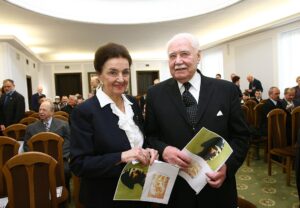
Ryszard Kaczorowski and Karolina Kaczorowska in the Senate of the Republic of Poland. The ceremony summing up the Year of General Władysław Anders, 27.02. 2008, Source: Senate of the Republic of Poland; photo by: Katarzyna Czerwińska. Wikimedia Commons, lic.: CC-BY-SA-3.0-PL
“Death row is an experience which reassures you that you are on the right track. When I was taken to the court in Minsk and saw that the entrance was manned by an NKVD platoon, I only then realised the importance they attached to us. And we – almost naked, emaciated after various tortures… I do not think I have ever lost faith that what I do is right and necessary”, he said in an interview.
Ryszard Kaczorowski, although he lived in London for most of his life, always felt like a Białystok citizen. He was born in Białystok on 26 November 1919. He spent his childhood in a small wooden house on Mazowiecka Street. At the age of 14, he joined in the Scouts, and in 1939 he became the deputy commander of the Białystok Scout Emergency Service. In October 1939, under the Soviet occupation, he was active in a secret scout troop, which in November became part of the Gray Ranks. On 17 July 1940, he was arrested by the NKVD and imprisoned in Białystok, and then in Minsk. After a months-long investigation, on 1 February 1941, a Soviet court in Minsk sentenced him to death for “joining the Polish, counter-revolutionary, insurrectionary ‘Gray Ranks’ organisation, which set itself the goal of overthrowing Soviet power in the western territories of Belarus by armed means.” Ultimately, after 100 days on death row, his sentence was commuted to 10 years in labour camps. He was sent to Kolyma to work in a gold mine in Death Valley. In March 1942, he joined the so-called Anders’ Army, with which he evacuated to Palestine. He took part in the Italian campaign as a soldier of the 3rd Carpathian Rifle Division, and during the Battle of Monte Cassino he was the commander of the communication center of the 2nd Carpathian Rifle Brigade. After the end of the war, he remained in exile in Great Britain, where he undertook active social and political activities in the exile authorities of the Republic of Poland. He was also involved in Polish scouting, where he met his future wife Karolina Mariampolska, whom he married in 1952.
On 19 July 1989, after the death of Kazimierz Sabbat, Ryszard Kaczorowski was sworn into the office of the President of the Republic of Poland in Exile. He held this office until 22 December 1990, when in Warsaw he handed over the insignia of power to Lech Wałęsa. He visited Poland and Białystok many times. He always said about himself that he was a scout and a Białystok citizen.
He died on 10 April 2010 in a plane crash near Smolensk on his way to Katyn for the celebration of the 70th anniversary of the Katyn Massacre.



